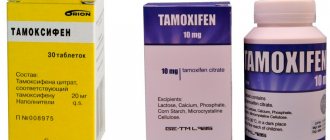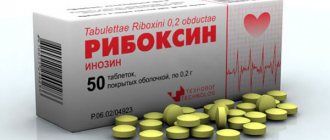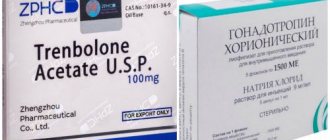Cabergoline is a drug that suppresses the natural production of prolactin in the body.
It helps normalize hormonal levels, which are disrupted due to physical (overwork, overtraining) and emotional (sleep disturbance, stress) factors, as well as from taking steroids. The drug appeared in the 80s and has been a leader in the sports medicine market since then. In our market it is sold under such trade names as “Bergolak”, “Dostinex” and from Fominsky Pharm. enterprises. The most popular brand is Dostinex. There are many analogues of this drug. Italy, in addition to Dostinex, offers the cheaper Cabaser. The Czech Republic produces Agaltex and Alakting. The medicine can be produced in dosages of 0.25 g, 0.5 g and 1 g. Its effect is identical and does not depend on the brand and price.
Cabergoline (Dostinex, Agalates, Bergolak)[edit | edit code]
Cabergoline tablets
(active ingredient) - suppresses the secretion of prolactin, in addition increases libido and erection, significantly reduces recovery time between sexual intercourse,[1] and also lowers blood pressure. Cabergoline is a derivative of ergot alkaloids; its mechanism of action is a dopamine (D2) receptor agonist. It is a more modern and safer analogue of bromocriptine.
The drug allows you to almost completely eliminate the main side effects of steroids such as Deca (Deca-Dic) and Trenbolone. One of the effects caused by a decrease in prolactin concentration is a decrease in fluid retention in tissues, which results in an increase in leaner muscle mass.
Cabergoline is available in pharmacies under the trade names:
Bergolak from Veropharm
- Bergolak (700-900 rubles for 8 tablets of 0.5 mg). (in 2014, the manufacturer did not renew the license; as of January 2016, production had not been resumed; management announced that production would be resumed in the summer of 2016; it is already on sale).
- Agalates (1000-1450 rubles for 8 tablets of 0.5 mg).
- Dostinex (1600-3000 rubles for 8 tablets of 0.5 mg) is an original drug that appeared on the market in 1985.
Prices are as of 10/08/2015
As of 03/02/2017
- Cabergoline (700-900 rubles for 8 tablets of 0.5 mg)
- Dostinex (1700-1900 rubles for 8 tablets of 0.5 mg)
As of 11/10/2017
- Cabergoline (700-900 rubles for 8 tablets of 0.5 mg)
- Bergolak (780-1000 rubles for 8 tablets of 0.5 mg)
- Dostinex (1500-2000 rubles for 8 tablets of 0.5 mg)
Mechanism of action[edit | edit code]
The main mechanism of action of cabergoline is the activation of D2 receptors, which are located on the lactotroph cells of the pituitary gland. Excitation of dopamine receptors in this area leads to a decrease in the secretory function of cells that produce prolactin.
In addition, interaction with other receptors was established: D3, D4, 5-HT1A, 5-HT2A, 5-HT2B, 5-HT2C, α2B. Antagonism with α2B receptors further explains the positive effect on erectile function (expansion of the cavernous bodies occurs).[2]
Pharmacological properties of cabergoline for men
The drug acts as an agonist of dopamine type receptors. The active substance is a derivative of ergoline, which allows it to have a strong prolactin-lowering effect. Cabergoline acts on dopamine receptors, which reduces the concentration of prolactin in the blood. The effectiveness of the drug is noticeable just three hours after use.
When cabergoline is used by men, it does not affect other hormones. The only associated effect is a decrease in blood pressure.
Application in bodybuilding[edit | edit code]
Experience with Iron Factor and Do4a.com has shown that the optimal regimen for using cabergoline to lower prolactin is as follows:
- During a course of progestin anabolic steroids (nandrolone, trenbolone): 0.25 mg (whole or 1/2 tablet) every 7-21 days, starting from the third or fourth week of the course, when the ACC concentration approaches its maximum. The optimal dose and frequency of administration are selected under the control of prolactin level tests, since the effect of the drug differs and depends on the individual characteristics of the body.
- When prolactin levels increase above the permissible level, the frequency of administration increases: 0.25 mg, every 4 days. It is advisable to perform a control analysis of prolactin after two doses with subsequent correction of the regimen.
The drug is taken with food or on an empty stomach.
Why is cabergoline needed in bodybuilding?
Athletes who take anabolic steroids often experience symptoms of gynecomastia. This is a serious disease caused by hormonal imbalance; it is expressed not only in the growth of the mammary glands, but is also manifested by the presence of lactation. In a man, when the nipple is squeezed, a small amount of fluid may be released. This symptom indicates hormonal imbalances. Usually this is an imbalance between estrogens, prolactin and medications. When symptoms appear, you need to adjust the dosage of anabolic steroids, and also use cabergoline if the concentration of prolactin increases.
Side effects[edit | edit code]
A study of 200 Parkinson's patients using high doses of cabergoline (0.5 mg every day) reported the following side effects:
- Digestive system (most common):
nausea, constipation, dry mouth, dyspepsia - Nervous system:
insomnia, dizziness, depression, distortion of consciousness - Cardiovascular system:
drop in blood pressure, peripheral edema, arrhythmia, valve damage, pericarditis - From the immune system:
rarely - hypersensitivity reaction, skin rash. - From the hematopoietic system:
infrequently - erythromelalgia. - From the respiratory system:
often - shortness of breath, infrequently - pleural effusion, pulmonary fibrosis, nosebleeds.
When using low dosages, side effects are quite rare or completely absent. The most commonly reported symptoms on forums are depressed mood and loss of appetite.
It is not recommended to take more than one tablet per week (with the exception of very elevated prolactin levels).
Symptoms of increased prolactin during a course of steroids?
Speaking about the growth of prolactin, it is worth mentioning a number of reactions of the body in the case of an increased concentration of this hormone.
Consequences and symptoms of increased prolactin:
- drop in libido;
- headaches, even dizziness;
- fluid retention;
- sleep disturbance;
- apathy;
- gynecomastia;
- obesity;
- galactorrhea (lactation) – the appearance of milk-like fluid from the breast in men;
- severe weakness;
- depression;
- increased appetite;
- acne.
How to treat gynecomastia in men after steroids
At different stages, pathology is treated with different methods. The basis of treatment is drug therapy, which is aimed at reducing the level of estrogen in the athlete’s blood.
When treating gynecomastia in bodybuilders, the most commonly used drugs are tamoxifen, additional testosterone, anastrozole, Proviron, exemestane, aromatase inhibitors, etc.
In some of the most advanced cases, the patient may require surgical intervention, since the breasts no longer have a “male appearance” and cannot be returned to their previous state. Such operations to correct the mammary glands or nipples are extremely rarely necessary; usually drug therapy produces results in the first months.
Causes of increased prolactin during a course of steroids?
While on a course of steroids, the chances of catching all these reactions are, of course, higher. Very often you can hear about a direct connection between the use of steroids and the increase in prolactin. But let's not rush to these conclusions!
There are many opinions on this matter, as well as a statement taken out of nowhere, which is circulating on forums, that the increase in prolactin is directly related to the dosage of steroids and especially the use of nadrolone. Not everything is so simple and if we study more cases, we can say that prolactin does not grow at all on a course of nadrolone, but on any course of steroids it grows perfectly, and at the same time it does not always grow at all on a course of steroids - this is also worth it emphasize yourself.
Personally, I will say that over the period of many years of working with people individually, I have observed dynamics, based on which I can safely say that there is no direct connection between the increase in prolactin and the use of nadrolones, and prolactin does not always increase during a course of steroids. In addition, given my great love for nadrolone, I conducted a lot of courses with people who contacted me and used nadrolone. Based on our statistics, it was established that there were many cases where there was no need to take cabergoline at all in order to suppress prolactin, since the level of this hormone was satisfactory throughout the entire course of steroids, both with and without nadrolones. So, we will not directly associate the increase in prolactin with steroids, but we will not exclude the fact of additional growth of the hormone during the steroid cycle, since there are such cases and there are many of them.
As for the reasons for the increase in prolactin on and off a course of steroids, I am ready to discuss this in detail in another article, which will certainly appear on the site and will be devoted specifically to prolactin. For now, let’s take a quick look at the main growth factors.
Additional growth of the hormone is promoted by:
- physical fatigue;
- lack of rest and sleep;
- use of anabolic steroids;
- liver and kidney diseases;
- autoimmune diseases;
- lack of B vitamins;
- smoking;
- frequent stress;
- long-term use of the following medications: antihypertensives, antidepressants, dopamine blockers;
- genetic predisposition to the growth of depressive enzymes MAO (monoamine oxidase);
- sex, ejaculation the day before testing.
Of course, it cannot be said that all these factors lead to an increase in prolactin in the human body. Not at all, everything is very individual and only a specialist can understand the reasons for growth. This article only helps you navigate general concepts and find some answers to your questions.
It is now more clear that in case of increased prolactin concentration, it is necessary to take cabergoline. It interacts with dopamine receptors located in the pituitary gland. Its use reduces the level of prolactin in the blood.
If this issue is not addressed, the situation can worsen and lead to various complications and irreversible processes, such as nodular gynecomastia, impotence and infertility.
When using cabergoline, you will be able to gain better muscle mass, as it removes excess fluid from the body. Libido will increase significantly, erection problems will be solved, blood pressure will improve, mood will improve, and the overall tone of the body will increase.
Contraindications
The medicine should not be taken:
- hypersensitivity reactions to the active component or derivatives of ergoalkaloids ;
- during lactation;
- patients with uncontrolled arterial hypertension ;
- pregnant women;
- with fibrotic changes in the heart muscle or respiratory organs, which cause disturbances in the functioning of the organs.
Caution is recommended:
- with low blood pressure;
- if therapy with dopamine receptor antagonists and antihypertensive drugs is carried out in parallel;
- for eclampsia or preeclampsia ;
- persons suffering from liver diseases;
- with psychosis , including a history;
- children.
Antipsychotic-associated hyperprolactinemia (ANH) is common in psychiatric practice. Therapeutic approaches to hyperprolactinemia of idiopathic and tumor origin have been well studied, while many controversial issues remain regarding the correction of GAN. There are several generally accepted treatment strategies for GAN: reducing the dose of the antipsychotic, replacing the drug with another one that increases prolactin levels to a lesser extent, and adding dopamine receptor agonists to psychotropic therapy. However, the patient’s mental state does not always allow reducing the dose of the antipsychotic or replacing the drug with another one.
In the treatment of other forms of hyperprolactinemia, drugs from the group of dopamine receptor agonists are successfully used. In patients with GAN, therapy with dopamine receptor agonists has not yet found widespread use, due to the likelihood of deterioration of the mental state [3]. The question of how much the use of dopamine receptor agonists negatively affects the course of a mental disorder remains open. In the available literature [6], there are descriptions of individual clinical cases of exacerbation of mental disorders when taking these drugs. L.N. Gorobets et al. [1] used cabergoline (1 mg per week) and bromocriptine (5 mg per day) in women with GAN for 1 month. An exacerbation of the course of the mental disorder was not detected in any case, however, the duration of treatment can hardly be considered sufficient to assess the possible psychotropic side effects of dopamine agonists. In another placebo-controlled study [8], 60 patients with GAN were prescribed bromocriptine in doses of 2.5, 2, 10 mg per day for 8 weeks, which was accompanied by a significant decrease, but not normalization of prolactin levels after 4 weeks, followed by an increase in prolactin levels despite continued use of bromocriptine; None of the patients had a deterioration in their mental status.
The mental state also remained stable in 25 women with GAN who received bromocriptine in doses of 1.25-8.75 mg per day for 3 months [3], as well as in 10 patients with GAN caused by risperidone who took cabergoline at a dose of 0.125 -0.25 mg per week for 16 weeks [11]; Against this background, 9 out of 10 patients showed normalization of prolactin levels and disappearance of symptoms of hyperprolactinemia. Similar results in a small sample (19 patients) were obtained when using cabergoline in the same doses for
8 weeks [5]. The use of low doses of cabergoline in these studies was due to concerns about possible exacerbation of mental illness.
C. Kalkavoura et al. [7] studied 80 patients with schizophrenia with GAN who took cabergoline for 6 months. Patients were divided into three groups depending on the initial prolactin level: less than 50 ng/ml, 50-100 ng/ml, higher
100 ng/ml (upper limit of normal 20 ng/ml in men, 25 ng/ml in women). In group 1, the daily dose of cabergoline was 0.25 mg, in group 2 - 0.5 mg, in group 3 - 1.0 mg. The study assessed sexual function using the Arizona Sexual Experience Scale (ASEX) questionnaire. Therapy was accompanied by a significant decrease in prolactin levels in all groups, a significant decrease in the total ASEX score and subscale scores. Worsening of the course of the mental disorder was not observed in any case.
Thus, the literature data (with the exception of [7]) concern the results of extremely short-term use of dopamine receptor agonists, which is obviously insufficient to assess the frequency of possible exacerbations of mental disorders. The short observation period does not allow us to evaluate some of the clinical effects of therapy, for example, the restoration of a regular menstrual cycle. In addition, studies on the correction of GAN with dopamine receptor agonists have often been conducted in very small groups, insufficient for analysis [3, 5, 11].
Most studies [3, 5] indicate that therapy with dopamine receptor agonists leads to a significant decrease in prolactin, but there is no information on what proportion of patients achieve normalization of prolactin, and how these patients differ clinically from the rest. No studies have assessed prolactin levels and clinical symptoms after discontinuation of dopamine agonists; therefore, it is unknown how long the clinical and laboratory effect lasts. Most publications evaluate the effect of dopamine receptor agonist therapy only on the reproductive system, and do not examine the dynamics of body weight and sexual function.
The purpose of our study is to study the clinical and laboratory effectiveness of dopamine receptor agonists in patients with GAN, including the dynamics of symptoms of hyperprolactinemia, sexuality and quality of life, as well as to assess the safety of the use of these drugs in patients with mental disorders. Cabergoline was chosen from the group of dopamine receptor agonists because it has the most convenient dosage regimen, which is especially important in patients taking a large number of psychotropic drugs.
Material and methods
The efficacy and safety of cabergoline in patients with GAN was studied in an open comparative prospective controlled study.
Patients of a psychiatric hospital (PKB No. 1 named after N.A. Alekseev, Moscow) were selected to participate in the study from February 2011 to November 2012. A complete screening of patients was carried out to identify GAN. The inclusion criteria for patients were: age 19-45 years, presence of a mental disorder requiring long-term use of antipsychotics. Exclusion criteria: pituitary disease, taking drugs other than antipsychotics that can cause an increase in prolactin levels, pregnancy and postpartum lactation, concomitant endocrine and somatic diseases that can lead to an increase in prolactin levels (hypothyroidism, renal, liver failure, etc. ). Cabergoline was recommended to all patients with GAN for the correction of hyperprolactinemia outside of exacerbation of mental disorder. Treatment with cabergoline (drug Agalates, IVAX "Pharmaceuticals sro", Czech Republic) was carried out only with the informed consent of the patients. 44 patients (4 men, 40 women), average age 30 years (26-33 years), received cabergoline treatment. Patients with GAN who refused to take cabergoline were included in the control group, which consisted of 40 patients (3 men, 37 women), comparable with patients of the main group in age, diagnoses, duration of mental disorder, composition of psychotropic therapy (Tables 1 and 2 ).
Randomization was not performed because patients were assigned to different groups depending on their willingness to take cabergoline for the correction of GAN.
Information about psychiatric diagnosis, duration of illness, mental status, and psychotropic therapy was taken from the inpatient medical history. The average duration of mental disorder was 3 years (0.5-7 years). All patients took psychotropic therapy, which included antipsychotics. Psychotropic therapy was not changed during cabergoline therapy.
All patients receiving cabergoline therapy were under the dynamic supervision of an endocrinologist and psychiatrist. Patients visited an endocrinologist once every 1-2 months. At each visit, a clinical examination, physical examination, body mass index (BMI) measurement were performed, and rating scales were used. The initial dose of cabergoline was 0.25 mg per week, the increase was carried out under the control of prolactin levels, with dose increments of 0.25-0.5 mg per month. The level of prolactin and bioactive prolactin was assessed before the start of treatment, then at intervals of 1-1.5 months until normalization. The study of bioactive prolactin allowed us to exclude cases of macroprolactinemia. After normalization of prolactin levels, cabergoline was discontinued. Patients who managed to achieve normalization of prolactin had a repeat blood test for prolactin 3 months after discontinuation of cabergoline. Patients in the control group were observed for 2 years; Data on exacerbation of mental disorder and hospitalization in a psychiatric hospital were recorded.
Serum prolactin levels were measured in mU/L (reference intervals for women were 90–540 mU/L and 60–510 mU/L for men).
It is known that prolactin can be presented in three different forms: biologically active, or low molecular weight prolactin
(23 kDa), dimeric prolactin (50-60 kDa), high molecular weight immunoreactive prolactin, or macroprolactin (150-170 kDa), a complex of low molecular weight prolactin with immunoglobulin G. The low molecular weight form has the greatest activity; dimeric prolactin and macroprolactin have low biological activity.
Bioactive prolactin was measured using the PEG precipitation method [2]. Reference intervals for women were 64-395 mU/l and for men - 73-380 mU/l. The amount of macroprolactin was determined by subtracting bioactive prolactin values from the total amount of prolactin. Hyperprolactinemia was considered to be a bioactive prolactin level above the upper limit of the reference interval. The determination of prolactin in serum was carried out using a Vitros 3600 analyzer (Johnson & Johnson) in the laboratory of biochemical endocrinology and hormonal analysis of the Endocrinological Research Center (head of the laboratory - Prof. N.P. Goncharov).
The SF-36 questionnaire was used to assess health-related quality of life. The assessment results are presented in points on 8 scales; a higher score indicated a higher level of quality of life. The following indicators were assessed: physical functioning (PF), physical role functioning (RP), pain intensity (BP), general health (GH), vital activity (VT), social functioning (SF), emotional role functioning condition (RE), mental health (MH). The scales were grouped into two indicators - the physical component of health (PH') and the mental component of health (MH') [10].
To semi-quantitatively assess the side effects of antipsychotics, the UKU - Udvalg for Kliniske Undersogelser scale questionnaire was used. The questions concerned body weight, sexuality, galactorrhea, and the menstrual cycle (for women). The presence and severity of each side effect were assessed in points (0 - no side effect, 1 - mild, 2 - moderate, 3 - severe) [11].
The PRSexDQ scale was used to assess sexual disorders during treatment with psychotropic drugs. The presence and severity of sexual disorders were assessed in points (0 - no disorder, 1 - mild, 2 - moderate, 3 - severe) [12].
Statistical analysis was carried out using Microsoft Office Excel 2007 and Statistica 8.0 for Windows, Release 8.0, USA. Quantitative data are presented as mean, standard deviation, median (Me) and interquartile range (1st and 3rd quartiles). To compare indicators before and after completion of cabergoline administration, the Wilcoxon test for paired comparisons and the &khgr;2 test were used. To compare quantitative indicators between groups, the Mann-Whitney test was used. Fisher's exact test and the &khgr;2 test were used to compare percentages.
The critical value for the level of statistical significance was considered to be p<0.05.
Results and discussion
44 patients received cabergoline for the correction of GAN. 6 patients stopped therapy early, 4 of them due to non-compliance, 2 due to subjective deterioration in well-being, expressed in increased anxiety and psycho-emotional lability. At the same time, the psychiatrist who observed the patients did not note a deterioration in their mental state. Two patients took cabergoline for a long time and stopped treatment on their own due to the ineffectiveness of therapy. One of them received cabergoline at a dose of 2 mg/week, and the second - 2.5 mg/week. In 36 patients (3 men, 33 women), it was possible to achieve normalization of prolactin levels; 1 patient became pregnant. Thus, with good tolerability of cabergoline and sufficient compliance, normalization of prolactin levels was achieved in 95% of patients.
The effective dose of cabergoline to achieve normalization of prolactin levels ranged from 0.25 to 3 mg per week [median 0.5 (0.5-1.25 mg)]. The duration of drug use to achieve an effect varied from 4 to 44 weeks [median - 14 (4-22 weeks)]. The total duration of drug use varied from 4 to 92 weeks. In some cases, treatment was continued after prolactin levels normalized (for example, in the presence of prolactinoma, when planning pregnancy).
In 17% of patients, clinical and laboratory effect was achieved when taking 0.25 mg of cabergoline per week, in 34% of patients it took 0.5 mg/week to achieve the effect, in 9% of patients - 0.75 mg/week, in 14% - 1.0 mg, 3% - 1.25 mg, 11% - 1.5 mg, 6% - 1.75 mg, 3% - 2.5 mg, 3% - 3 mg/week (Fig. 1).
Figure 1. Clinical and laboratory efficacy of different doses of cabergoline in the treatment of GAN.
In 37% of patients, therapy was required for 4-8 weeks to achieve effect. In 34% of patients, the clinical and laboratory effect occurred after 10-17 weeks of taking cabergoline, in 17% - after 22-25 weeks, in 11% - after 36-44 weeks. After normalization of prolactin, cabergoline was discontinued in 34 patients (3 men, 31 women); two patients continued therapy as indicated. Prolactin levels were assessed 3 months after discontinuation of cabergoline treatment. In 10 (29%) patients, hyperprolactinemia was observed in combination with the resumption of clinical symptoms. Most patients with recurrent GAN received a second course of cabergoline therapy. The distribution of patients according to the duration of therapy required to normalize prolactin levels is shown in Fig. 2.
Figure 2. Duration of cabergoline therapy to achieve effect in GAN.
In the group of patients in whom it was possible to achieve normalization of prolactin levels, before treatment it was 1730 mU/l (1240-2535), after completing cabergoline it was 272 mU/l (204-448) (p<0.001) (Fig. 3 ).
Figure 3. Prolactin levels at baseline (1) and after stopping cabergoline (2) for the correction of GAN.
In one patient, an MRI of the brain revealed a pituitary adenoma measuring 4×13×6 mm. The patient suffered from a mental disorder for more than 13 years and took antipsychotics. Clinical symptoms of GAN appeared several years after the start of psychotropic therapy. It can be assumed that in this case, hyperprolactinemia while taking antipsychotics led to the development of a pituitary adenoma. The patient's treatment results were excluded from the final statistical analysis and are reported separately. The effective dose of cabergoline was 2.75 mg per week; clinical and laboratory effect was achieved after 52 weeks of therapy. The total duration of taking cabergoline was 92 weeks. At a control MRI of the brain after 12 months of cabergoline therapy, the adenoma was of the same size. Considering the size of the adenoma and stable mental state, it was decided to continue taking cabergoline at a dose of 2.75 mg per week.
To assess the clinical effectiveness of cabergoline therapy, a group of patients in whom prolactin normalization was achieved was analyzed. Of these, 33 were female. Menstrual irregularities before the start of therapy were observed in 29 (87.9%) patients: oligomenorrhea - in 16 (48%), amenorrhea - in 10 (30%), polymenorrhea - in 2 (6%), dysmenorrhea - in 1 (3). %). After normalization of prolactin levels, there was a significant decrease in the frequency of symptoms of hyperprolactinemia: menstrual irregularities occurred in 5 (15%) patients: oligomenorrhea - in 3 (9%), amenorrhea - in 2 (6%). When comparing the frequency of menstrual irregularities initially and after normalization of prolactin levels, the differences were statistically significant (p <0.001) (Table 3).
Before treatment, 27 (84%) patients had galactorrhea, spontaneous - in 8 (25%), with pressure on the mammary glands - in 19 (59%). After normalization of prolactin levels, galactorrhea with pressure on the mammary glands persisted in 1 (3%) patient. Thus, treatment with cabergoline led to a significant reduction in the incidence of galactorrhea (p<0.001).
Body weight before taking cabergoline was 65 (55-73) kg, after normalization of prolactin levels it increased to 68 (60-76) kg (p = 0.0047).
In 2 (5%) patients, while taking cabergoline, anxiety and psycho-emotional lability increased somewhat, which is why the drug was discontinued.
In other cases, treatment was well tolerated; Even with long-term use of the drug, no side effects were noted. There were no hospitalizations in a psychiatric hospital during therapy.
In the control group of 40 people, 15 (37.5%) experienced an exacerbation of mental disorder during the observation period, which required hospitalization. Thus, in the group of patients taking cabergoline, there were fewer exacerbations than in the control group. This may be due to the lower compliance of patients in the control group, which is why they refused both treatment with cabergoline and regular use of psychotropic medications.
When comparing quality of life indicators (SF-36 questionnaire) initially and after normalization of prolactin levels, the following data were obtained (Table 4).
Thus, normalization of prolactin levels in patients with HAN is associated with a significant improvement in quality of life indicators on scales of social functioning, role functioning due to the emotional state, and the psychological component of health. Social functioning measures the extent to which a physical or emotional condition limits social activities (communication). An increase in scores on this scale indicates improved social functioning and a decrease in physical or emotional limitations. Emotional Role Functioning assesses the degree to which emotional states interfere with performance at work or other daily activities. An increase in scores on this scale indicates an improvement in the performance of daily work and a decrease in limitations due to emotional state.
When comparing the indicators of the UKU questionnaire, the following data were obtained (Table 5).
Consequently, normalization of prolactin levels in patients with GAN is associated with a decrease in scores on the scale of menstrual irregularities according to the oligo-amenorrhea type (UKU-4), the galactorrhea scale (UKU-5), the scale of weakened sexual desire (UKU-7), the scale of impaired orgasm (UKU-8), total number of points. A decrease in scores indicates a decrease in the severity of these side effects.
When comparing the parameters of the PRSexDQ questionnaire in patients at baseline and after normalization of prolactin levels, no significant differences were obtained (Table 6).
In this study, most patients were treated with cabergoline for a long time and in higher doses than in other studies [1, 4, 5, 11]. In particular, cabergoline treatment was carried out for the first time for more than 6 months (8 patients) and almost 12 months (3). This made it possible to more reliably estimate the possible frequency of exacerbations of mental disorders while taking cabergoline. For the first time, the level of bioactive prolactin was studied, which made it possible to exclude cases of macroprolactinemia and evaluate the dynamics of bioactive prolactin during treatment with cabergoline. For the first time, the effect of correction of GAN with cabergoline on quality of life indicators was studied. The effect on sexual function was also assessed. There is only one publication in the available literature [7] about a similar study involving a large group of patients. In our work, for the first time, prolactin levels were assessed 3 months after cabergoline discontinuation and the frequency of relapse of GAN was identified. Possible limitations of the study include the following: the study group consisted primarily of female patients; therefore, the results obtained on indicators of quality of life, sexual function and body weight apply to a greater extent to women. In addition, it is difficult to exclude the influence of other factors on the quality of life and sexual function, in addition to the correction of GAN with cabergoline.
The results obtained will be useful primarily to psychiatrists and endocrinologists, as they provide the opportunity for an active and reliable approach to the treatment of GAN.
conclusions
1. Therapy with cabergoline for 4-22 weeks in patients with GAN allows one to achieve a clinical and laboratory effect in 95% of cases. After discontinuation of cabergoline, the effect persists in 71% of patients; 29% experience recurrence of GAN. Treatment of GAN with cabergoline is safe and does not lead to worsening of the course of the mental disorder, even with long-term use of the drug.
2. The effective dose of cabergoline in patients with GAN is 0.5 (0.5-1.25) mg; Duration of administration to achieve effect: 14 (4-22) weeks.
3. Normalization of prolactin levels in women with GAN with the help of cabergoline leads to the disappearance of galactorrhea and the restoration of a regular menstrual cycle. Correction of GAN with cabergoline does not have a significant effect on body weight.
4. In patients with GAN, after treatment with cabergoline, there is a significant improvement in the following indicators of quality of life: social functioning, role functioning due to the emotional state, and the psychological component of quality of life. In addition, normalization of prolactin levels is accompanied by a significant improvement in sexual function (sexual desire and orgasm).
Author contributions:
Study concept and design
— E.G. Starostina, L.K. Dzeranova, I.I. Grandfathers
Collection and processing of material
— O.A. Yunilainen, G.S. Kolesnikova, G.V. Katsia, N.P. Goncharov,
A.B. Synica, E.G. Rytik, E.N. Tulintseva
Statistical data processing
— O.A. Yunilainen
Writing text
— O.A. Yunilainen
Editing
— E.G. Starostina, L.K. Dzeranova, I.I. Grandfathers
The authors declare that there are no conflicts of interest or financial interest related to the manuscript.











